


| The world's first domestic natural cheese created by fermenting and maturing using koji mold and sake lees has been developed in Japan. Its name is "Koji Cheese KURA" (Fig.1). It is characterized by its unique flavor created by koji and sake lees. It goes well with Japanese sake, making it possible to enjoy a traditional "Japanese" flavor. Led by Nippon Veterinary and Life Science University, a consortium of seven institutions including Zao Dairy Center, Higuchi Matsunosuke Shoten Co., Ltd., and the National Agriculture and Food Research Organization has been established, and the cheese is a major result of promotion of joint research through industry-academia collaboration. By mixing with sake lees from local sake breweries, it is possible to make local koji cheese that is unique to that area, and therefore it can be expected to revitalize the area with specialty products. | 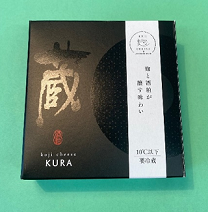 Fig.1 Package containing "Koji Cheese KURA" (Provided by Zao Dairy Center) |
Sold at the Zao Dairy Center in Miyagi Prefecture, rich in umami ingredients
This summer, Zao Dairy Center, located in Zao Town, Miyagi Prefecture, began selling the world's first koji mold cheese "Koji Cheese KURA" (Fig.2), which is matured with koji and sake lees. It is a premium cheese selling for 1620 yen (tax included) per piece (100g). It is sold at the direct sales store (Fig.3) adjacent to the Zao Factory and the online shop.
A dedicated manufacturing facility was created in June 2020, and after many prototypes, the cheese was finally completed. It is a donut-shaped soft cheese that looks similar to Camembert, but it is aged with koji mold and sake lees is added, making it possible to enjoy a unique taste that is a fusion of Japanese and Western flavors.
Raw milk, lactic acid bacteria, koji mold, sake lees, and salt are the only raw materials used to make koji cheese. It contains nearly five times more glutamic acid, an umami component, in comparison with Camembert, making it possible enjoy a flavor that cannot be experienced with other cheeses./p>
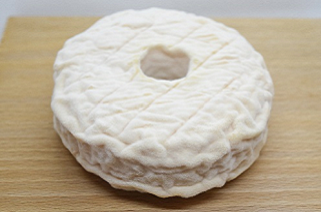 |
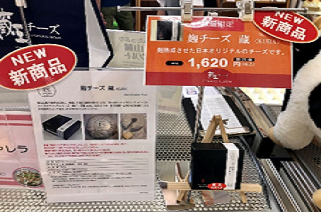 |
| Fig.2 Koji cheese aged with koji mold and sake lees (Provided by Zao Dairy Center) | Fig.3 Zao Dairy Center direct sales shop (Provided by Zao Dairy Center) |
Short ripening period and high profitability
While soft white mold cheese such as Camembert takes 3 to 4 weeks to mature, koji cheese matures for only about 10 days, ensuring high production efficiency and high profitability. Since there is no cheese using koji mold in other countries, it is possible to differentiate it from imported cheese, and it also has the strength of having little risk of being involved in price competition.
Selected from about 2000 types of koji mold
Koji mold (Aspergillus oryzae) is a microorganism indispensable for the fermentation of miso, soy sauce, sake, etc. since ancient times. It has been attempted for some time to create cheese using koji mold, but it has not been put to practical use since koji mold does not adhere well to the surface of the cheese. There was also a problem that the milk fat in raw milk was excessively decomposed by the action of koji mold, and the flavor decreased.
Professor Kaoru Sato of Nippon Veterinary and Life Science University, with the cooperation of Higuchi Matsunosuke Shoten Co., Ltd. (Osaka City), which is known for manufacturing and selling koji mold, and the Institute of Livestock and Grassland Science, NARO (NILGS), Institute of Food Research, NARO (NFRI), selected 12 strains of koji mold that have characteristics such as easy decomposition of milk proteins and rapid maturation from about 2,000 strains of koji mold. Using these, a prototype of koji mold cheese was created, and the koji mold "KC43" strain (KC stands for Koji Cheese), which has characteristics such as good flavor and low lipolytic activity, was selected.
In addition, since koji mold is comprised of fine particles with a diameter of 10 μm or less, there was success in providing it in a capsule form (Fig.4) that prevents it from scattering and makes it easier to handle.
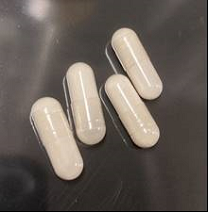
Fig.4 Capsule containing koji mold
(provided by Professor Kaoru Sato)
Birth of local koji cheese using sake lees
| While developing various koji cheeses, the idea of adding "sake lees" was born. With the cooperation of Hakkaisan Brewery Co., Ltd. (Minamiuonuma-shi, Niigata Prefecture), which boasts a history of 100 years, sake lees suitable for the flavor and structure of koji cheese were selected, and a unique koji cheese with the flavor of sake lees was created (Fig.5). There are over 1,300 sake breweries in Japan. By using sake lees from sake breweries in each region, it is possible to create local koji cheese with different flavors. Working to popularize local koji cheese, Prof. Sato remarked, "About 90% of the cheese consumed in Japan is imported. A unique Japanese cheese that is as good as any imported cheese has finally been born. Koji cheese is the world's first soft cheese with a umami-rich taste. It also goes well with Japanese cuisine, and therefore the applications for cooking are endless. It is my hope that the spread of new cheeses will strengthen Japan's dairy production base." | 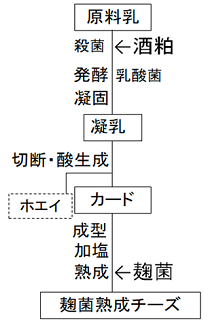 Fig.5 Manufacturing process of koji mold matured cheese |
Project name
The special scheme project on vitalizing management entities of agriculture,forestry and fisheries
Project period
FY 2018 to 2020
Title
Development of unique Japanese natural cheese manufacturing technology using domestically produced fermented microorganisms
Leading research institutes
Nippon Veterinary and Life Science University, Zao Dairy Center, Matsunosuke Higuchi Co., Ltd., Hakkai Brewery Co., Ltd., Institute of Livestock and Grassland Science, NARO (NILGS), Institute of Food Research, NARO (NFRI), Kyoritsu Women's University Graduate School, University of Yamanashi, etc.
